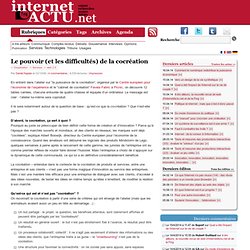

Le pouvoir (et les difficultés) de la cocréation. Par Daniel Kaplan le 02/10/08 | 4 commentaires | 8,530 lectures | Impression En entrant dans l’atelier sur “la puissance de la cocréation”, organisé par le Centre européen pour l’économie de l’expérience et le “cabinet de cocréation” Favela Fabric à Picnic, on découvre 12 tables carrées, chacune entourée de quatre chaises et équipée d’un ordinateur.

Le pouvoir (et les difficultés) de la cocréation. La Co-Création est Beaucoup Plus que du Crowdsourcing. 1inShareinShare1 Un des thèmes les plus discuté du web depuis quelque années est celui du Crowdsourcing, un moyen pour les enterprises d’ “engager” les utilisateurs en leur faisant participer à la création même de la marque.

Malheureusement ce concept de crowdsourcing a été réduit trop vite au modèle User Generated Advertising, partie plus visible et avec une influence sûrement importante coté retombées médiatiques, mais qui ne répond pas toujours aux besoins marketing d’une entreprise et surtout n’apporte pas une vraie valeur aux consommateurs. Crowd sourcing / co creation / co design. The Power Of Co-Creation.
Owp.whitepaper.96dcbb5c2c80c791.4f6e6c696e652d436f6d6d756e69746965735f434d6d384f36476f2e706466.pdf (Objet application/pdf) End users. Les limites de la cocréation. Who participates in co-creation, and what do participants expect ? One of the most brilliant answers I’ve read is given by Johann Füller, CEO of Hyve, in his research paper Refining Virtual Co-Creation from a Consumer Perspective.

He highlights that a lot has been written about the empowerment of the consumer, the capabilities provided by the web or the benefits of collabporative innovation, but “our understanding about who participates and what those participants expect from their engagement in virtual co-creation projects is limited“. In his paper, he explores how heterogeneous participants are and how co-creation focused companies should handle these different personnalities. In his litterature review, he recalls that beside the 4Fs of co-creation, which are fun, fulfilment, fortune & fame (he doesn’t use these terms, I do), there can be other motivations to engage in co-creation: seeking information, satisfying a particular need or finding friends. Fantastic Four motivations for co-creation. Co-creation is a way to integrate real consumers in the development of companies’ new offers.

Hence, these companies benefit from crucial input coming up from the market, as long as they’re able to organize and leverage communities of co-creators. Last year, Doug Williams from Forrester Research issued a report that revealed a stunning 61% of US adults being willing co-creators ! Consumers Are Willing Co-Creators: More On The Intersection Of Social Media And Consumer Product Strategy. In a prior post, I told you that 83% of companies use social media, but fewer than half of those have product teams that are currently using social media to influence product design, creation, or strategy.

In that report, I also divulge that 72% of consumer product strategy (CPS) professionals claim that social media will enhance their existing capabilities of using customer input to shape product strategy. I've also posted about how social co-creation is an important opportunity for consumer product strategy (CPS) professionals -- and it's something that some, but not all, of those companies who are active with social media use. For those CPS pros who are not actively engaging in social co-creation, a common question is, "Do consumers want to co-create? And will they want to co-create with me? " We asked US online adults those very questions, and in a word, the answer is YES. Stay tuned for more research on this topic. Résultats Google Recherche d'images correspondant à. Social media agency London. CO-CREATION’S 5 GUIDING PRINCIPLES or.... what is successful co-creation made of? In challenging times new rules apply.

Companies and organisations are searching for tools that can help them win battles. Daily challenges have to be faced. Future growth paths have to be found. 10 steps for successful co-creation.
Eight Styles of Co-Creation: A Model and Definitions. By: Chris Lawer I have been working on a new framework that will help me to scope down my research into how firms can co-create knowledge with their customers.

To do so, I began to identify different styles of co-creation based on a number of distinguishing criteria such as: THE NATURE OF THE VALUE CREATED – What form of value the co-creation primarily creates – products, services or experiences WHO IS PRIMARY BENEFICIARY - Who benefits from the involvement of the customer and the exchange of their knowledge? In the end, I settled on two factors which distinguished different styles of co-creation.
These are: The degree of adaptability or personalisation of the value created, with standard, fixed products at one end of the scale and unique, personalised, adaptable experiences at the other To open the powerpoint version of the model (much more readable), click here. Co-création. Un article de Wikipédia, l'encyclopédie libre.

La cocréation consiste, pour une entreprise, à développer des produits ou services en collaboration active avec ses clients et ce, de façon durable[1]. Après une première phase durant laquelle la cocréation a été utilisée comme un outil d’innovation pour les produits et les services, la cocréation se développe aujourd’hui comme vecteur de transformation des entreprises[2]. La cocréation de produit ou service avec le client arrive au deuxième rang des priorités des dirigeants marketing pour la période 2010-2012 selon le baromètre Cegos[3].
Explication de la cocréation[modifier | modifier le code] Historique du concept[modifier | modifier le code] La co-création (2ème partie) : les acteurs.